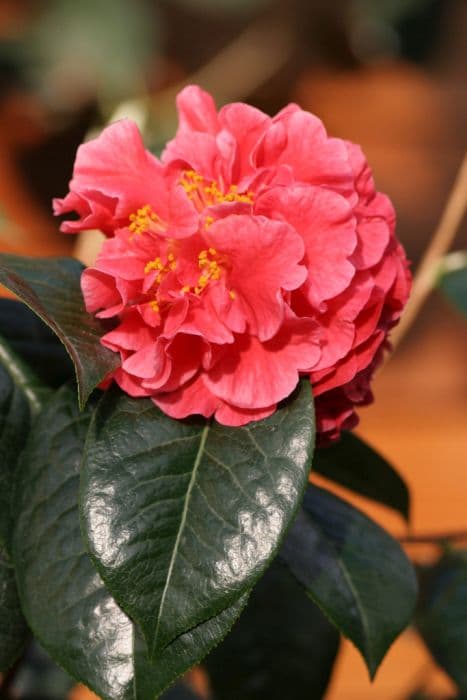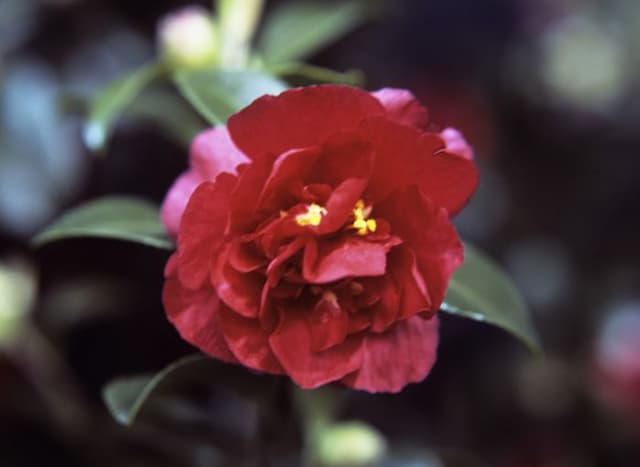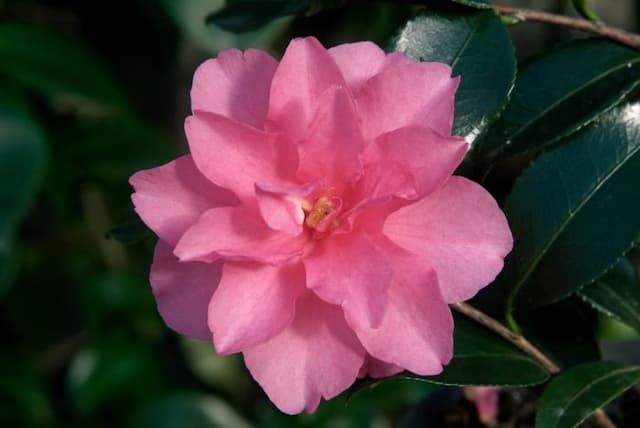Williamsii Camellia Camellia × williamsii 'Donation'

ABOUT
The Camellia 'Donation' is a visually striking plant, renowned for its abundant floral display. It is characterized by large, semi-double blooms that exhibit a soft pink color, providing a gentle yet captivating aesthetic. These blossoms are known for their generous petal arrangement and typically reveal a cluster of golden-yellow stamens at their center, adding a contrasting touch that enhances their appeal. The foliage of the Camellia 'Donation' contributes to its lush appearance, with glossy, dark green leaves that offer a year-round display of verdancy. The leaves exhibit a leathery texture and are elegantly shaped, with a smooth margin that outlines their oval to elliptical form. This backdrop of rich green perfectly frames the vibrant flowers, which emerge during the blooming season and enliven the plant's overall presence. The plant embodies a rounded and bushy habit, providing a full and dense look that is both neat and attractive. This structure allows it to serve as an excellent option for ornamental purposes, fitting well into various garden designs where it can shine as a specimen or be integrated into borders and beds for seasonal interest. Overall, the Camellia 'Donation' is celebrated for its striking combination of opulent flowers and luxurious foliage, making it a favored choice among gardeners and plant enthusiasts who wish to add a touch of elegance and captivating color to their outdoor spaces.
About this plant
 Names
NamesFamily
Theaceae
Synonyms
Donation Camellia
Common names
Camellia × williamsii 'Donation'
 Toxicity
ToxicityTo humans
Camellia 'Donation' is generally considered non-toxic to humans. However, consumption of any plant material can potentially cause some form of gastrointestinal discomfort due to the presence of naturally occurring compounds in plants. Symptoms might include nausea, vomiting, or diarrhea, but such reactions are rare. It is always best to avoid ingesting plant parts if you are unsure about their safety.
To pets
Camellia 'Donation' is also considered non-toxic to pets. Like humans, if pets ingest parts of this plant, they may experience some mild gastrointestinal upset, but serious poisoning is unlikely. If you notice your pet consuming this plant, watch for symptoms of nausea, vomiting, or diarrhea, and consult your veterinarian if any concerns arise.
 Characteristics
CharacteristicsLife cycle
Perennials
Foliage type
Evergreen
Color of leaves
Dark green
Flower color
Pink
Height
8-12 feet (2.4-3.7 meters)
Spread
6-10 feet (1.8-3.0 meters)
Plant type
Shrub
Hardiness zones
7-9
Native area
East Asia
Benefits
 General Benefits
General Benefits- Ornamental Appeal: Camellia 'Donation' features attractive, large pink flowers that add aesthetic value to gardens and landscapes.
- Extended Blooming Season: This plant typically blooms from winter to spring, providing color during a time when few other plants are flowering.
- Evergreen Foliage: The glossy green leaves of Camellia 'Donation' remain on the plant all year, offering constant visual interest.
- Durability: Camellia 'Donation' is relatively hardy and can tolerate winter temperatures in many climates, making it suitable for a variety of garden settings.
- Low Maintenance: Once established, Camellia 'Donation' requires minimal care beyond occasional pruning and watering during dry periods.
- Wildlife Attraction: Its flowers can attract pollinators such as bees to the garden, aiding pollination of nearby plants.
- Privacy Screen: Due to its dense growth habit, Camellia 'Donation' can be used as an evergreen screen or hedge, providing privacy and wind protection.
 Medical Properties
Medical PropertiesThis plant is not used for medical purposes.
 Air-purifying Qualities
Air-purifying QualitiesThis plant is not specifically known for air purifying qualities.
 Other Uses
Other Uses- Camellia × williamsii 'Donation' can be used in the production of non-yellowing, high-quality drying oils for artists' paints, providing a stable medium that does not influence the color pigments over time.
- Its wax can be harvested and used in the cosmetics industry for the production of creams and lotions, bringing a smoothing and emollient quality to these products.
- The petals of this camellia may be used in the creation of natural dyes, providing hues ranging from pinks to reds for textiles.
- Though not a common use, the leaves have the potential to be processed into a natural insect repellent, thanks to certain oils they contain.
- Landscape artists use this plant for topiary, as its dense growth can be trimmed into various shapes for ornamental purposes.
- The blossoms can be used in the preparation of floral jellies, where they impart a delicate flavor and aroma to the preserves.
- The wood, being hard and of a fine grain, can be used to craft small items like handles, knobs, or inlay work in woodworking projects.
- Camellia × williamsii 'Donation' can be featured in bonsai form, offering a unique and challenging specimen for enthusiasts due to its larger flower size.
- Its petals can be cottoned and incorporated into a naturally scented potpourri mix, adding a gentle fragrance to a room.
- The spent blossoms and leaves can be composted and contribute to a nutrient-rich additive for the garden, supporting the organic growing of other plants.
Interesting Facts
 Feng Shui
Feng ShuiThe Camellia is not used in Feng Shui practice.
 Zodiac Sign Compitability
Zodiac Sign CompitabilityThe Camellia is not used in astrology practice.
 Plant Symbolism
Plant Symbolism- Adoration: The camellia flower, in general, is often associated with admiration and deep affection, hence 'Donation' could be seen as a gift of love and adoration.
- Perfection and Excellence: With its luscious petals and flawless appearance, the camellia represents the pursuit of perfection and excellence.
- Longevity and Faithfulness: Camellias are known for their long blooming season and sturdy nature, symbolizing the endurance and fidelity in relationships.
- Pride: In certain cultures, the camellia can signify pride or overweening pride, as it stands tall and dignified among other flowers.
- Gratitude: 'Donation' could be indicative of gratitude, making it an appropriate gift to express thanks and appreciation.
 Water
WaterThe Camellia 'Donation' should be watered deeply to ensure moisture reaches the roots, roughly 1 inch of water per week. During dry spells, water every 5-7 days, providing about 2-3 gallons per watering session to maintain evenly moist soil. Overhead watering should be avoided to prevent flower blight; instead, water at the base of the plant. It's crucial not to overwater, as Camellias are sensitive to waterlogged conditions, which can lead to root rot.
 Light
LightCamellia 'Donation' thrives in partial shade with dappled sunlight. The ideal spot is protected from hot afternoon sun, which can scorch the leaves and fade the flowers. Morning sun with afternoon shade provides the best lighting conditions for vibrant growth and bloom production.
 Temperature
TemperatureCamellia 'Donation' prefers temperatures between 60 and 80 degrees Fahrenheit, though it can tolerate winter temperatures down to 20 degrees Fahrenheit. Avoid exposure to temperatures above 90 degrees Fahrenheit, as it may stress the plant and lead to bud drop.
 Pruning
PruningThe Camellia 'Donation' should be pruned after it finishes blooming in spring to maintain desired shape and size and to remove any dead or weak wood. Light pruning helps improve air circulation and encourages healthy growth. Pruning is not an annual necessity but done as needed to manage the plant's form.
 Cleaning
CleaningAs needed
 Soil
SoilThe Williamsii camellia requires acidic soil with a pH of 5.5 to 6.5 for optimal growth. An ideal soil mix would consist of 50% peat moss or ericaceous compost, 30% perlite, and 20% pine bark fines to ensure good drainage and aeration. Regularly check the soil pH to maintain the acidity levels preferred by the plant.
 Repotting
RepottingWilliamsii camellias should be repotted every 2 to 3 years. The best time to repot is in the late winter or early spring before the new growth starts. Choose a pot only slightly larger than the current one, as camellias prefer to be somewhat root-bound.
 Humidity & Misting
Humidity & MistingWilliamsii camellias thrive in moderately high humidity, ideally between 40% to 60%. Ensure consistent humidity levels without significant fluctuations to promote healthy growth and flower production.
 Suitable locations
Suitable locationsIndoor
Place in bright, indirect light and maintain high humidity.
Outdoor
Plant in partial shade, shelter from strong winds, well-draining soil.
Hardiness zone
7-9 USDA
 Life cycle
Life cycleThe Camellia 'Donation' begins its life cycle when a seed germinates, usually in spring, developing a root system and a shoot that emerges from the soil. The plant then enters a vegetative stage where it focuses on growth, producing glossy, evergreen leaves and a sturdy stem structure. As it matures, usually after a few years, it begins to produce buds in late summer to autumn, which will overwinter before blooming into large, showy flowers in late winter to spring. After pollination, which may be facilitated by bees or other insects, the flowers will fade and the plant will develop seed pods if conditions are right. Once the seeds mature, they are dispersed by various means, potentially starting a new plant's life cycle if they land in a suitable environment for germination. Throughout its life, which can span several decades, the Camellia 'Donation' will go through repeated cycles of growth, flowering, and seed production, punctuated by seasonal periods of dormancy.
 Propogation
PropogationPropogation time
Spring-Early Summer
The most popular method of propagation for Camellia × williamsii 'Donation', commonly referred to as Donation camellia, is through semi-hardwood cuttings. This practice is generally done in late summer to early fall, after the new growth has matured and started to harden. To propagate, a 4 to 6-inch cutting is taken with several leaves left at the top. The lower leaves are removed, and the cut end is dipped into rooting hormone before being placed into well-drained potting mix. The pot should then be covered with plastic to retain humidity and kept out of direct sunlight. Rooting can take several weeks, and once the new plants have developed a strong root system, they can be transplanted into the garden.









